Disneyland – Anaheim, California
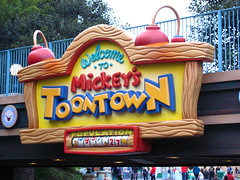 Enter Mickey’s Toontown: a garish styrofoam city that resembles an expensive Six Flags Looney Tunes Land rather than anything I would have expected to see at Disneyland. Gone are the restrained, aesthetically balanced European fairytale sensibilities found in Fantasyland (and with it a sense of innocence), and in its place are loopy curlicues and retina-burning colors that resemble a bad Tex Avery cartoon; why the classic Disney characters belong here continues to leave me slightly baffled. Ironically, Toontown’s edgier, caricatured take on the financial success of Who Framed Roger Rabbit feels more dated today than the timeless 1950’s environment of surrounding Fantasyland. (The signature dark ride opened nearly six years after the movie’s release anyway, so even in its prime it was already a bit outdated.) The best that can be
Enter Mickey’s Toontown: a garish styrofoam city that resembles an expensive Six Flags Looney Tunes Land rather than anything I would have expected to see at Disneyland. Gone are the restrained, aesthetically balanced European fairytale sensibilities found in Fantasyland (and with it a sense of innocence), and in its place are loopy curlicues and retina-burning colors that resemble a bad Tex Avery cartoon; why the classic Disney characters belong here continues to leave me slightly baffled. Ironically, Toontown’s edgier, caricatured take on the financial success of Who Framed Roger Rabbit feels more dated today than the timeless 1950’s environment of surrounding Fantasyland. (The signature dark ride opened nearly six years after the movie’s release anyway, so even in its prime it was already a bit outdated.) The best that can be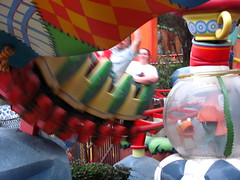 said about Toontown is that it’s the one place in Disneyland that hides no shame of its blatant artificiality. Given that the rest of the park works so carefully to achieve an illusion of “magical reality”, the shock of confronting Mickey’s Toontown is somewhat akin to hiring a comedian to heckle the cast of a Tchaikovsky ballet production.
said about Toontown is that it’s the one place in Disneyland that hides no shame of its blatant artificiality. Given that the rest of the park works so carefully to achieve an illusion of “magical reality”, the shock of confronting Mickey’s Toontown is somewhat akin to hiring a comedian to heckle the cast of a Tchaikovsky ballet production.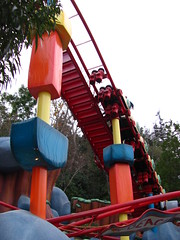
The infrastructure is atrocious as well, being a plainly tacked-on kiddie cash-grab on what was formerly a vacant lot outside of the “official” park borders long established by the Disneyland Railroad. Required to cross a trench beneath the train tracks to access, the area forms a claustrophobic cul-de-sac that requires any visitor to eventually turn around and backtrack their paces. It doesn’t even require a busy day for this pathway to become a bottlenecked sea of people, the quizzical expressions on the entrant’s faces meeting the disappointed gazes of those on their way out. To summarize metaphorically, Mickey’s Toontown is the appendix of Disneyland, a dead-end vestigial midway filled with shit and probably needs to be removed for the overall health of the entire park.
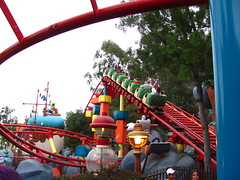 One would do well to avoid this area of the park completely, but unfortunately in my case I had a coaster count to tend to and number 429 was waiting for me at the far back end of Toontown in the form of Gadget’s Go Coaster. This is a small-sized (207 meter) variety of Vekoma Junior Coaster with random blocks of synthetic wood-imitation affixed to the support structure, themed to look exactly like a Vekoma Junior Coaster with random blocks of synthetic wood-imitation affixed to the support structure. The sign out front warned of a 40 minute queue, which was almost enough for me to dump the coaster credit and go straight back out to Fantasyland, but a quick survey of the area indicated the queue couldn’t have been more than half that time, so we joined the line and ten minutes later were seated on the ride.
One would do well to avoid this area of the park completely, but unfortunately in my case I had a coaster count to tend to and number 429 was waiting for me at the far back end of Toontown in the form of Gadget’s Go Coaster. This is a small-sized (207 meter) variety of Vekoma Junior Coaster with random blocks of synthetic wood-imitation affixed to the support structure, themed to look exactly like a Vekoma Junior Coaster with random blocks of synthetic wood-imitation affixed to the support structure. The sign out front warned of a 40 minute queue, which was almost enough for me to dump the coaster credit and go straight back out to Fantasyland, but a quick survey of the area indicated the queue couldn’t have been more than half that time, so we joined the line and ten minutes later were seated on the ride.
Given the slapdash mad invention appearance and the fact that it’s named after a cartoon personality named “Gadget”, one would be correct in assuming that it’s themed after a supporting character from “Rescue Rangers”, a short-lived daytime Disney Channel TV series that was canceled three years before the roller coaster opened. The interactive setting the track narrowly dodges between, including a small tunnel and water fountains with jets squirting overhead, makes it marginally better than the average Roller Skater. Then again, the average Roller Skater doesn’t require its single 16-passenger train to service the crowds of the second highest annually attended theme park worldwide.
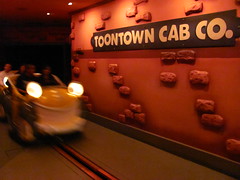 If you’re not bumming for coaster credits, there is one ride in Toontown that’s worth a peek if lines are short: Roger Rabbit’s Car Toon Spin. It is another Disney attraction that tries to condense the movie narrative into a three-minute dark ride format, a storytelling tactic I generally consider misguided because result is inevitably an incoherent mess. However, it works slightly better for Roger Rabbit because the shadowy, hyperactive cartoon aesthetics take on a nightmarish quality that is amplified by the broken fragments of quotes and images, as if
If you’re not bumming for coaster credits, there is one ride in Toontown that’s worth a peek if lines are short: Roger Rabbit’s Car Toon Spin. It is another Disney attraction that tries to condense the movie narrative into a three-minute dark ride format, a storytelling tactic I generally consider misguided because result is inevitably an incoherent mess. However, it works slightly better for Roger Rabbit because the shadowy, hyperactive cartoon aesthetics take on a nightmarish quality that is amplified by the broken fragments of quotes and images, as if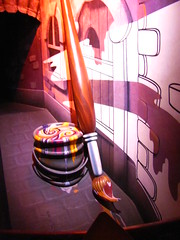 we’ve entered a four-dimensional dream space after falling asleep from a stoned screening of the original 1988 movie. A more memorable effect is a “free fall” scene where the set is built at a 90 degree tilt so it appears as though we’re rushing past skyscrapers toward the ground, with the sort of off-kilter physics and anthropomorphic buildings that so often characterize a good nightmare. There are a few other decent gags including Roger’s arm stretching halfway across the set, the “Bull in a China Shop” room, and numerous instances of synapse-frying strobes, sparks, and psychedelic imagery. Then there’s the spinning device, which allows us to “steer” our taxi cab vehicle in 360° circles, not unlike the Mad Hatter’s Tea Cup ride. You can try to steer your car so you’re kept facing forward (sometimes easier said than done) but at least one time before the ride’s over you’ve got to let loose and crank it as hard as you can so the ride turns into a neon blur. However, this is also easier said than done due to the addition of restrictors on the spin axel.
we’ve entered a four-dimensional dream space after falling asleep from a stoned screening of the original 1988 movie. A more memorable effect is a “free fall” scene where the set is built at a 90 degree tilt so it appears as though we’re rushing past skyscrapers toward the ground, with the sort of off-kilter physics and anthropomorphic buildings that so often characterize a good nightmare. There are a few other decent gags including Roger’s arm stretching halfway across the set, the “Bull in a China Shop” room, and numerous instances of synapse-frying strobes, sparks, and psychedelic imagery. Then there’s the spinning device, which allows us to “steer” our taxi cab vehicle in 360° circles, not unlike the Mad Hatter’s Tea Cup ride. You can try to steer your car so you’re kept facing forward (sometimes easier said than done) but at least one time before the ride’s over you’ve got to let loose and crank it as hard as you can so the ride turns into a neon blur. However, this is also easier said than done due to the addition of restrictors on the spin axel.
 Like anything else in Disneyland, Mickey’s Toontown is not really bad enough to warrant immediate removal or avoidance when so many other theme parks would be lucky to have a kiddieland of this caliber. But as I already said, even with a reasonably strong dark ride like Roger Rabbit, the area seems tonally incorrect for Disneyland. Should they follow the lead of the Magic Kingdom and replace it with an expansion of the existing Fantasyland, I for one wouldn’t shed any tears.
Like anything else in Disneyland, Mickey’s Toontown is not really bad enough to warrant immediate removal or avoidance when so many other theme parks would be lucky to have a kiddieland of this caliber. But as I already said, even with a reasonably strong dark ride like Roger Rabbit, the area seems tonally incorrect for Disneyland. Should they follow the lead of the Magic Kingdom and replace it with an expansion of the existing Fantasyland, I for one wouldn’t shed any tears.
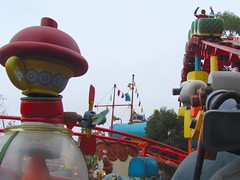
Comments